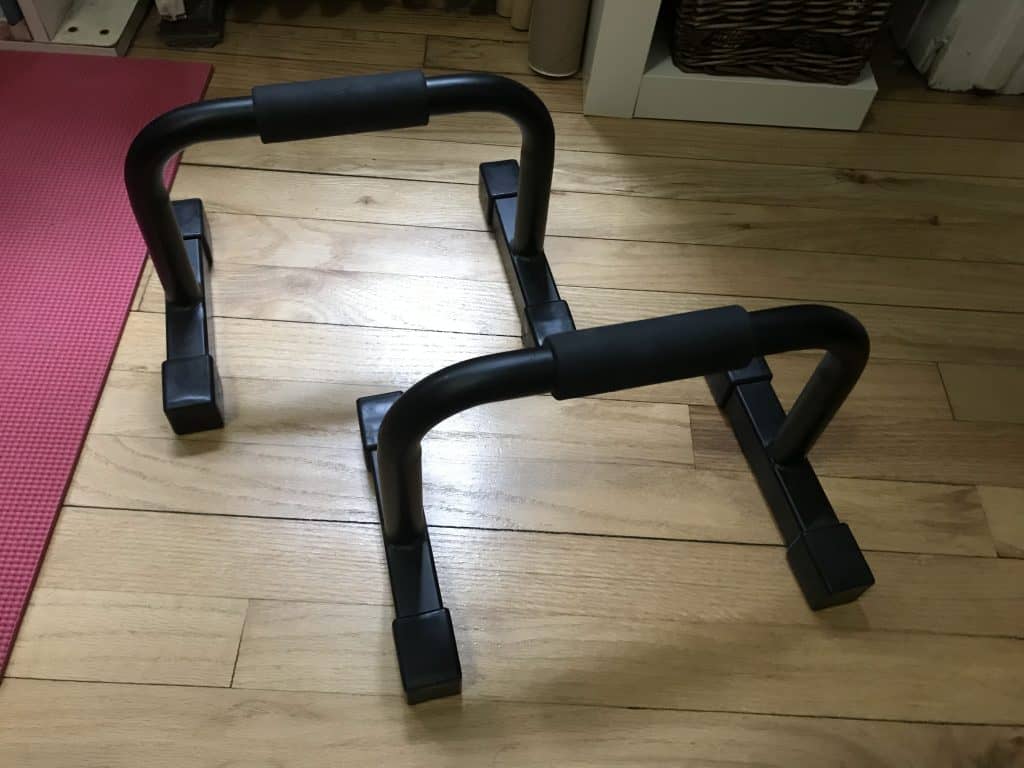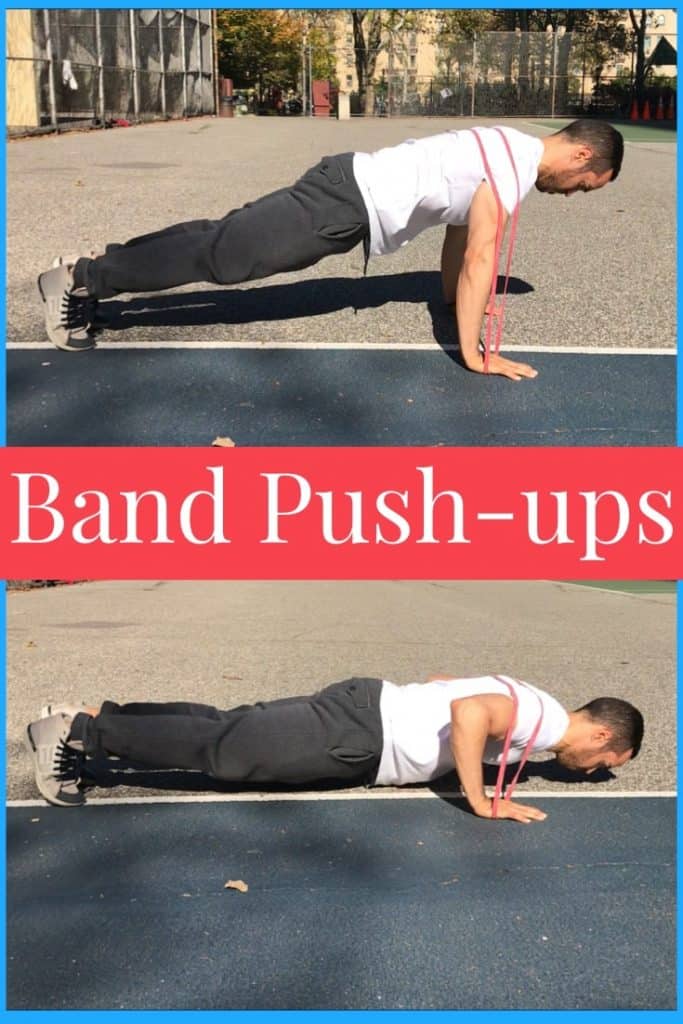How many push-ups should you be able to do?
While there is no universally accepted answer, below are some goals to strive for based on your age, biological sex, and fitness level.
Plus, these are all realistic numbers for everyday busy people.
Keep reading to learn more.

How Many Pushups Should I Be Able To Do?
On average, men should be able to do at least ten push-ups, and women should be able to do at least five.
The younger and more athletic you are, the higher number of push-ups you should be able to do.
A lower body weight also helps.
Now, if you can’t do five or ten push-ups yet, that’s ok!
We all start somewhere. With focus and consistency, you can slowly build up your strength.
I’ll show you how in just a moment.
How Many Pushups Can An Average Person Do?
If you’re a male with average genetics, here are some average push-up numbers to strive for:
- Decent: 10
- Good: 25
- Optimal: 35
- Advanced: 50
- Athlete: 60
As a female, your average push-up numbers would look something like this:
- Decent: 5
- Good: 10
- Optimal: 18
- Advanced: 30
- Athlete: 40
If you’re interested – you can also check out how many pull-ups you should be able to do as well.
Push-up Standards By Age
Here is a table showing push-up standards by age group and biological sex.
| Age | Males | Females |
|---|---|---|
| 18-25 | 35 | 18 |
| 26-30 | 30 | 15 |
| 31-39 | 25 | 12 |
| 40-49 | 18 | 10 |
| 50-59 | 12 | 7 |
| 60+ | 10 | 5 |
Keep in mind that this is just an average, and many factors can affect how many push-ups you can do, especially if you have had prior injuries.
How Many Pushups Is Considered Strong?
If you can do 30 or more push-ups in one set, you have an excellent level of relative upper body strength.
However, once you pass this threshold, there is only so much strength you can build beyond this amount.
In other words, doing more than 30 push-ups in one set won’t necessarily make you any stronger.
To continue to develop higher levels of strength, your goal should be to:
- add external resistance (such as a weight vest)
- use weights (dumbbell or barbell bench press which train a lot of the same muscles)
- or do a more challenging variation push-up variation.
More on that later.
How Many Pushups Should I Do A Day To Gain Muscle?
You should treat push-ups just like any other compound exercise.
Twice a week, you should do at least three sets of push-ups with as many repetitions as possible. Ideally, you should aim for a minimum of 8–12 reps per set but no more than 30.
You can do more than six sets in a week, but there are probably diminishing returns above ten sets.
As always, use proper form and stop your sets before reaching absolute muscle failure.
Lastly, it is important that you train your back (with an exercise like a row) with an equal amount of frequency as you do your chest to create balance.
Are Pushups Enough To Stay Fit?
No, push-ups alone are not enough to stay fit. They are a great way to build upper-body pushing strength, but you need to pair them with other exercises for optimal results.
In addition to push-ups, you should also make an effort to target all the other major muscle groups in the body.
These include the back, shoulders, legs, and core.
I cover all of these here:
- The Best Bodyweight Back Exercises
- The Best Bodyweight Shoulder Exercises
- The Best Bodyweight Leg Exercises
- The Best Bodyweight Core Exercises
- The Best Bodyweight Exercises For Big Arms (Optional)
Lastly, you should also include aerobic exercises in your workout routine for cardiovascular health. These include activities such as jogging, cycling, or swimming.
Are Slow Push-ups Better?
Slow push-ups can be beneficial for building muscular endurance and hypertrophy.
The slower the tempo, the more time your muscles have to build tension. Increased time under tension helps increase both muscular activation and muscle fiber recruitment.
In addition, doing them slowly can help you learn good form.
You shouldn’t always do them slowly, but it can be a great way to mix up your routine from time to time.
Note: You can also get a similar benefit by using short rest periods between sets.
Other Related Questions
What Are The Benefits of Pushups?
- The push-up strengthens the horizontal pressing muscles, which are essential for pushing objects away from you.
- A properly executed push-up teaches you how to maintain your shoulder joint in a stable position which is an integral part of injury prevention.
- Push-ups also engage your core muscles which can help you to gain strength and stability in your trunk region.
- There are dozens of ways to do a push-up, allowing you can scale it up or down to challenge yourself.
- Lastly, it requires no formal equipment, meaning you can do it anywhere.
What Muscles Are Worked by Pushups?
- Chest (Pectoralis Major)
- Triceps
- Anterior Deltoids (Shoulders)
- Serratus Anterior (via Scapular Protraction)
- Upper Back (via Scapular Retraction)
- Abdominal muscles (Rectus Abdominis)
- Glutes
How to Properly Execute a Pushup
Here is a short video showing the proper technique.
I cover the push-up technique in much more detail here.
Safety Tips
There are many ways to perform a push-up incorrectly. The key is to get the starting position right.
Here is a quick checklist to ensure you are using the correct form.
Neck Position
- Keep your neck neutral and in line with your spine.
Back Position
- Do not let your spine sag. Keep your abs tight, and your glute muscles engaged the entire time. You should be able to draw a straight line from your neck down to your ankles.
Hand Placement
- Your hands should be directly underneath your elbows, which should be directly underneath your shoulders. Also, place your hands with your palms flat on the ground outside of shoulder width.
Elbow Position
- Do not flare your elbows out. Keep them close to your torso to about a 45-degree angle.
Shoulder Position
- Do not let your shoulders internally rotate. When descending, keep your shoulder blades retracted back and down to keep your shoulders back in their sockets. Ideally, your chest should touch the ground on every rep. If you can’t touch the floor without keeping your shoulders rotated back, elevate your hands on an incline.
If at any point you are feeling pain, stop immediately.
Pushup Variations
Here is a video demonstrating different push-up variations you can do, whether you are a beginner or more advanced.
In the video, I show:
- Wall push-ups
- Incline push-ups (on an elevated surface)
- Knee push-ups (on your knees)
- Standard push-ups (Regular push-ups)
- Close-grip push-up (often called the diamond push-up)
- Paused push-ups
- Decline Push-ups (with your feet elevated)
These are just the beginning.
I cover several more variations (along with progressions and regressions to all the best bodyweight exercises) in my Home Workout Program 2.0!

Pushup Equipment
If you are interested in purchasing equipment to help make your push-ups more challenging, you can consider the following:
Push-Up Bars:
Push-up bars provide a greater range of motion and reduce stress on the wrists.

Resistance Bands:
Resistance bands are a great way to add resistance to the push-up movement.
By looping the band around your body and hands, you can create resistance that makes it harder to press up.

Weighted Vest:
If you are looking for a more intense push-up workout, consider getting a weighted vest.
Weight vests allow you to add extra load to your body and make the push-up more challenging.
Gymnastic Rings:
Gymnastic rings allow you to perform push-ups on an unstable surface.
The instability of the rings forces your muscles to work harder and helps build core strength and stability.
Final Words
Push-ups are an excellent exercise for developing upper body muscle and strength.
If you are unable to meet the standard push-up criteria, use the regressions above to build up your strength gradually.
The goal shouldn’t be to do as many push-ups as possible but to do them with perfect form.
Once you have perfected the standard version, you can add variations and equipment to progressively overload your muscles and increase difficulty.
Now I want to hear from you.
Can you pass our push-up test?
How often do you include push-ups in your training program?
Comment below and let us know!
Related Articles:
- The Complete List of Calisthenics Exercises For Every Muscle Group
- A Quick & Efficient Bodyweight Workout Plan For Beginners (No Gym Needed)
- How Strong Are You? 7 Fitness Tests To Measure Where You Stand

Alex Robles, MD, CPT / Brittany Robles, MD, MPH, CPT
Alex & Brittany Robles are physicians, NASM Certified Personal Trainers, and founders of The White Coat Trainer: a resource dedicated to improving the health and fitness of busy professionals using time-efficient strategies. Their advice has been featured in My Fitness Pal, Prevention, Livestrong, Reader’s Digest, Bustle, The Active Times, and more. Learn more about them here.
